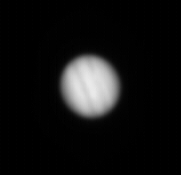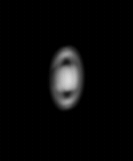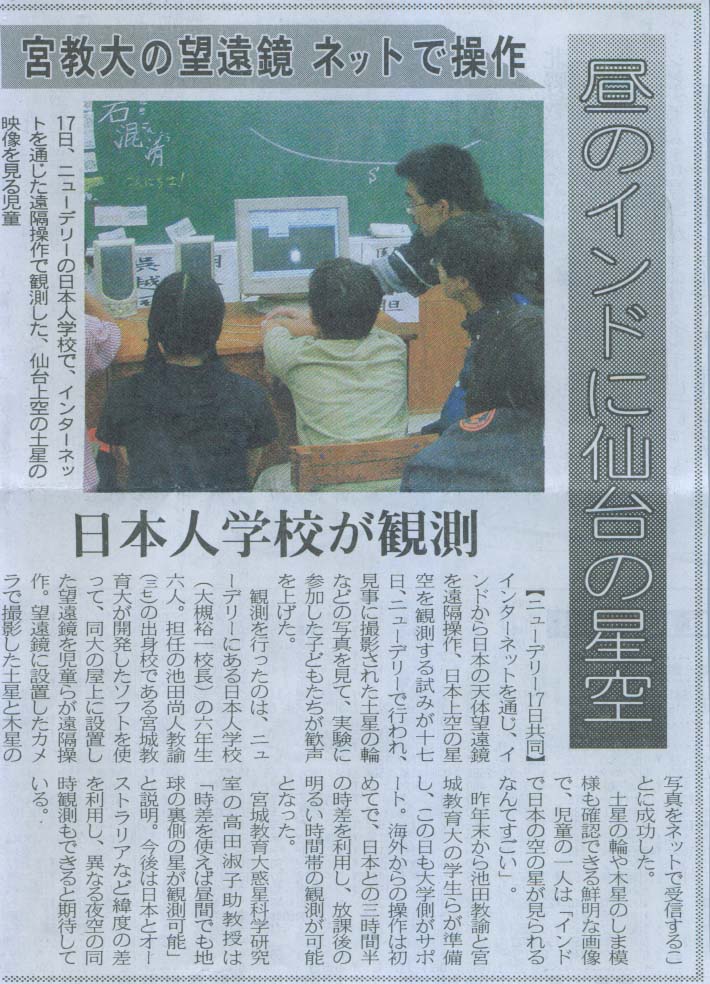HOME|Ideas and resoueces for planetary science experiments|Japanese School in India (2002)
宇宙の実験教室
Ideas and resoueces for planetary science experiments
カテゴリ
Category
- 実験教室Idea and Resources for Space science experiments
- 対象項目別Category: Contents
- 学年単元別Category: Study Age
-
- 実践授業Activity Reports
タグ
Tag
 宮教大の望遠鏡で星を見よう(インド日本人学校 2002)
宮教大の望遠鏡で星を見よう(インド日本人学校 2002)
インド日本人学校から遠隔操作
インド日本人学校から遠隔操作
2003年2月17日、インド日本人学校教諭 池田尚人教諭と6年生の児童6名が宮教大のインターネット望遠鏡を遠隔操作し、星空の授業を実施しました。
インド時間16:30からの授業ですが、日本との時差は3時間半、日本時間では20:00で星空観察に十分なほど暗くなっています。
インターネットを通じて、1時間ほどの間に天体望遠鏡と冷却CCDカメラを遠隔操作することに成功。 土星と木星の観察を行い、CCDカメラでの撮像を行いました。
撮像した木星と土星
 |
 |
| 木星 (2003.2.17 撮像) | 土星 (2003.2.17 撮像) |
授業終了後に児童6名に対して「自分で望遠鏡を操作した実感がありましたか」「システムが公開されたら利用しますか」という 二つの質問をしたところ、6名全員が「はい」と答えました。
アンケートでも「初めて惑星を見たことはずっと忘れない」「日本の夜の星空が見られて感動した」等、授業は児童に大きな感動を呼んだようです。
また、「もっと他にもたくさんの星を見てみたい」「こんなシステムがあれば望遠鏡での観察が身近になる」とインターネット天文台システムの公開に向けて励ましになる声も多数頂きました.
宮教大インターネット望遠鏡システムが2002年より課題としてあげていた「操作の実感」は確実に上がって来ているようです。また「操作の実感」があればこそ、それに伴い「システムを利用したい」という気持ちにつながってくるのでしょう。
新聞でも紹介
河北新報でも紹介されました。

2003年2月18日 河北新報 掲載記事 全文
昼のインドに仙台の星空
宮教大の望遠鏡 ネットで操作 日本人学校が観測
【ニューデリー17日共同】
インターネットを通じ,インドから日本の天体望遠鏡を遠隔操作,日本上空の星空を観測する試みが十七日,ニューデリーで行われ, 見事に撮影された土星の輪などの写真を見て,実験に参加した子供たちが歓声を上げた.
観測を行ったのはニューデリーにある日本人学校(大槻裕一校長)の六年生六人.担任の池田尚人教諭(三七)の出身校である 宮城教育大が開発したソフトを使って,同大の屋上に設置した望遠鏡を児童らが遠隔操作.望遠鏡に設置したカメラで撮影した土星と 木星の写真をネットで受信することに成功した.
土星の輪や木星のしま模様も確認できる鮮明な画像で,児童の一人は「インドで日本の空の星が見られるなんてすごい」.
昨年末から池田教諭と宮城教育大の学生らが準備し,この日も大学側がサポート.海外からの操作は初めてで,日本との三時間半の時差を 利用し,放課後の明るい時間帯の観測が可能となった.
宮城教育大惑星科学研究室の高田淑子助教授は「時差を使えば昼間でも地球の裏側の星が観測可能」と説明.今後は日本とオーストラリアなど 緯度の差を利用し,異なる夜空の同時観測もできると期待している.
 Japanese School in India (2002)
Japanese School in India (2002)
Remote operation from the Japanese School in India
Remote operation from the Japanese School in India
On 17th Feb. 2003, teacher Ikeda and 6 children from 6th grade at the Japanese School in India operated the MUE Internet Telescope from the classroom.
In the classroom it is 16:30 Indian time, but with a 3.5 hour time difference, it is already 20:00 in Japan and the sky is dark enough to observe the stars.
Using the Internet, they succeeded in operating the astronomical telescope and cooled CCD camera remotely for about an hour. Jupiter and Saturn were observed, and images were acquired using the CCDA camera.
Jupiter and Saturn Images Acquired
 |
 |
| Jupiter(Acquired 2003.2.17) | Saturn(Acquired 2003.2.17) |
After the demonstration was complete, the pupils comments included: "It was exciting to be operating a real telescope myself" and "We would like to use this system again"
Also "I will never forget my first view of another planet through a telescope!", "It was very impressive to see the night sky of Japan". The class appeared to make a big impression on the pupils.
Other comments: "We would like to look at a wider range of objects", "This system allows us to learn how to use a telescope". It was encouraging that there were a lot of requests to use the use the telescope system again.
The MUE Internet Telescope system was attracting interest from 2002 on, mainly due to the feeling of "virtual reality". This sense of virtual reality is probably why there have been so much interest in using the system.
News Article
This exercise featured in an article of the Kahoku Shimpo.

18th Feb. 2003 The Kahoku Shimpo Article Reproduction
The Night Sky of Sendai seen in India at Noon
MUE Telescope Operated via Internet Used by Japanese School
【New Delhi, 17th】
Using the Internet, a Japanese telescope was operated remotely from India to observe the night sky of Japan on the 17th. Children in New Delhi who participated in the exercise were very excited to be looking at images of objects such as Saturn's rings, which were photographed beautifully.
Observations took place at the Japanese School in New Delhi (principal Otsuki Hirokazu) with six students from 6th grade. Under the guidance of their teacher Ikeda (37), they used software developed at the graduate school of MUE to remotely operate a telescope on the roof of MUE. They successfully observed and photographed Jupiter and Saturn using a web cam.
With a clear picture allowing the rings of Saturn and belts of Jupiter to be seen, one pupil exclaimed: "It is wonderful that we can see the night sky in Japan from the classroom in India!"
The teacher Ikeda and MUE senior students had been preparing for this project since end of the last year, with support from the university. By taking the unique step of operating a telescope from a foreign country, they could make use of the three-and-a-half hour time difference between India and Japan, and observe during normal school hours.
"By observing across time zones, it is possible to observe celestial objects in the daytime", said Assistant Professor Takata of MUE Planetary Science Laboratory. In future, this system will be used to compare the appearance of the night skies of Japan and Australia, to show the variation with latitude.











